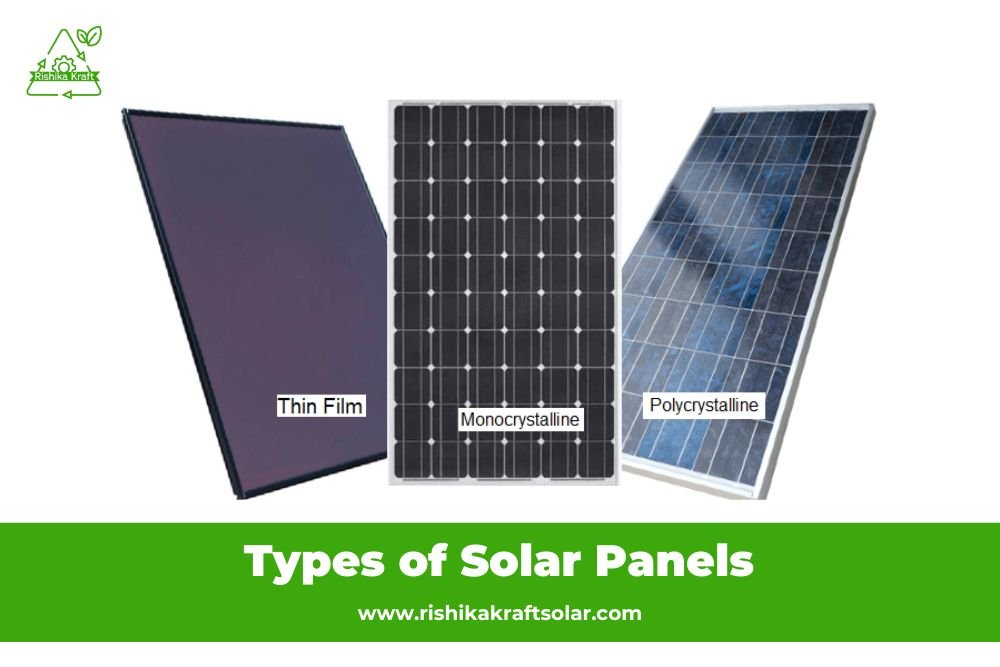Are you thinking about switching to solar energy? With so many options available, choosing the right solar panel can be confusing. Whether you are aiming to lower energy bills, reduce your carbon footprint, or increase property value, understanding the different types of panels is crucial. The ideal solar panel for you depends on the system you plan to install. Over the past 130 years, solar technology has evolved to improve efficiency, lower costs, and enhance aesthetics and durability. In this blog, we'll explore three types of solar panels that are excellent choices for the upcoming year.
There Are Primarily Three Different Types of Solar Panel
- Monocrystalline Solar Panels
- Polycrystalline Solar Panels
- Thin-film Solar Panels
1. Monocrystalline Solar Panels:
Monocrystalline solar panels are made from single crystals of silicon. The process used to make them is called the Czochralski method. In this process, a silicon crystal is placed in molten silicon and then carefully pulled out, allowing the molten silicon to form a crystal shell known as an ingot. The cells on these panels usually look black because black absorbs light better, making them more efficient. They are known for their high efficiency, durability, and reliability. These panels are more efficient than older types and perform well in low light or cloudy weather. However, they can be more expensive and less efficient in very hot conditions.
2. Polycrystalline Solar Panels:
Polycrystalline solar panels are made from fragments of silicon crystals. Their blue, textured surface panels have efficiencies ranging from 15% to 17%. The use of multiple silicon crystals in each photovoltaic (PV) cell enhances their energy conversion capability and durability. Although they are less efficient than monocrystalline panels, their lower manufacturing cost makes them a popular choice. Polycrystalline panels effectively convert sunlight into electrical energy, providing an affordable and reliable option for solar power systems. They are affordable, have a lifespan of about 25 years, and can be used for various applications. However, they employ older technology, which makes them less efficient, particularly in low-light and cloudy conditions.
3. Thin-Film Solar Panels:
Thin-film solar panels are made from extremely thin layers of photovoltaic materials, which can be over 300 times thinner than traditional silicon panels. These panels are lightweight and flexible due to their built-in semiconductors, making them the lightest option available. However, they are less efficient than crystalline panels, requiring more space to generate the same amount of electricity. As a result, they are typically used in large-scale operations like utility plants. Despite their lower efficiency, thin-film panels are popular for portable applications, such as on RVs, due to their lightweight and flexibility. They are also cheaper to install but not ideal for home use. Thin-film panels are made with light-absorbing layers between thin sheets of conductive material protected by a glass layer. These panels may appear blue or black, depending on the materials used. They are lightweight, flexible, and cheaper to install but have lower efficiency and are not ideal for residential use.
How Efficient Are Different Types of Solar Panels?
Efficiency varies among solar panels. If your roof space is limited, you should choose high-efficiency panels.
- Crystalline solar panels: Medium to high efficiency
Monocrystalline panels are the most efficient, often exceeding 22% and producing over 300 watts of power, sometimes even 400 W. Polycrystalline panels typically reach only 17% efficiency and produce lower wattage. Monocrystalline panels perform better in hot weather because they remain more efficient in the heat. Both polycrystalline and monocrystalline panels are available in sizes of 60, 72, and 96 silicon cells.
- Thin-film solar panels: Low efficiency
Thin-film panels are less efficient, around 11%, and produce less power than crystalline panels.
Which One is the Best Choice?
Monocrystalline, polycrystalline, and thin-film panels each have their pros and cons. The best choice depends on your property and savings goals. If you have plenty of space for solar panels, you can save money upfront by choosing cheaper, lower-efficiency polycrystalline panels. If space is limited and you want to save the most on your electric bill over 20 years, opt for high-efficiency monocrystalline panels. Thin-film panels are used for portable or DIY solar setups, like on RVs or boats. Businesses also choose them for large commercial roofs that can't support the weight of traditional panels. These roofs can handle the lower efficiency of thin-film panels because they have more space.
In the end, monocrystalline solar panels often emerge as the preferred choice for many due to their balance of cost, efficiency, and versatility, making them a strong option for a wide range of solar energy applications.


